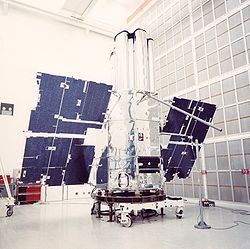- Orbiting Astronomical Observatory
-
 Le satellite Copernicus (OAO-3)
Le satellite Copernicus (OAO-3)
Le programme Orbiting Astronomical Observatory (OAO) constitue une famille de quatre satellites artificiels lancés par la NASA entre 1966 et 1972. Ils effectuèrent les premières observations en haute résolution de nombreux objets dans le domaine de l'ultraviolet.
Bien que deux missions OAO échouèrent, le succès des deux autres fit prendre conscience à la communauté astronomique des bénéfices des observatoires spatiaux, et mena quelques années plus tard à la création du télescope spatial Hubble.
Sommaire
OAO-1
Le premier télescope OAO fut lancé avec succès le 8 avril 1966, avec des instruments de détection de rayonnements ultraviolet, X et gamma. Cependant, avant même que les instruments ne puissent être activés, une panne de courant mit fin à la mission au bout de trois jours.
OAO-2
OAO-2 fut lancé le 7 décembre 1968. À son bord, un couplage de 11 télescopes ultraviolet. Le satellite, en service jusqu'en janvier 1973, contribua à de nombreuses découvertes astronomiques.
OAO-B
OAO-B était pourvu d'un télescope UV de 96 centimètres de diamètre, et aurait dû fournir les spectres d'objets peu lumineux. Malheureusement, le 3 novembre 1970, jour de son lancement, la coiffe du lanceur ne s'ouvre pas. Le télescope et son lanceur retombent dans l'atmosphère terrestre, ce qui met fin à la mission.
OAO-3 (Copernicus)
Article détaillé : Copernicus (satellite).OAO-3 fut lancé le 21 août 1972 et resta en service durant plus de neuf ans, jusqu'en février 1981. Cette mission fut un succès, le plus important du programme OAO. Copernicus retourna des spectres de haute résolution de centaines d'étoiles.
Sources
- Code A.D., Houck T.E., McNall J.F., Bless R.C., Lillie C.F. (1970), Ultraviolet Photometry from the Orbiting Astronomical Observatory. I. Instrumentation and Operation, Astrophysical Journal, v. 161, p.377.
- Rogerson J.B., Spitzer L., Drake J.F., Dressler K., Jenkins E.B., Morton D.C. (1973), Spectrophotometric Results from the Copernicus Satellite. I. Instrumentation and Performance, Astrophysical Journal, v. 181, p. L97.
- NSSDC Master Catalog : OAO-1, OAO-2, OAO-B, OAO-3.
Voir aussi
Articles connexes
Liens externes
Catégories :- Télescope spatial UV
- Télescope spatial à rayons X
- Observatoire spatial gamma
- Programme spatial de la NASA
Wikimedia Foundation. 2010.
